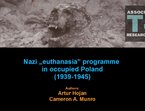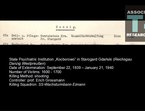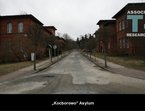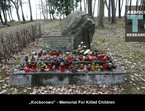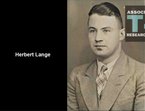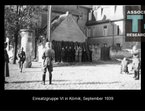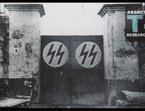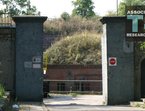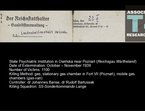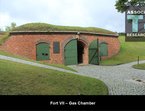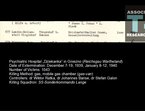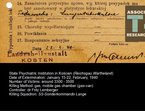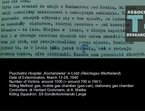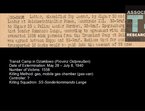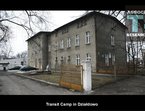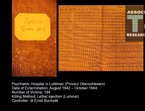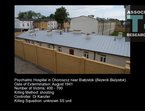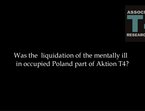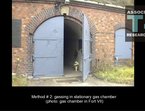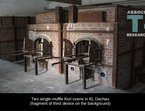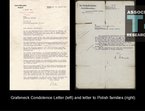- Navigation:
- Start
- »
- OUR PRESENTATIONS
- »
- Nazi Euthanasia Programme in Occupied Poland 1939-1945
Nazi Euthanasia Programme in Occupied Poland 1939-1945
During the conference, "Nazi Euthanasia in European Perspective" (Berlin, Kleisthaus, Feb. 28-30, 2013) we presented lecture "Nazi Euthanasia Programme in Occupied Poland". It was a shortened version of our article from the book "Man To Totalitarianism: From Simple Formulas to the Final Solution, "published by the Auschwitz-Birkenau State Museum and International Youth Meeting Centre in Oswiecim in 2012. Because many people were interested in our presentation and after the lecture asked us for some information, we decided to post almost the entire text of the lecture, and most of the slides from the presentation. Please remember that this is only the transcript. The entire version of the academic text (with citations and full historiographical apparatus) is included in the mentioned book, which you can buy from on-line bookshop of Auschwitz-Birkaneu Museum web-page.
No part of this text and photos below may be reproduced, stored in a retrieval system, or transmitted in any form or by any means electronic, mechanical, photocopying, recording or otherwise without the written permission of the authors.
Authors:
Artur Hojan
Cameron Munro
Overview of Nazi „euthanasia” program in occupied Poland (1939-1945)
Introduction
The twentieth century was a unique century, dissimilar to any other period in the history of mankind. It was a time that was marked by organized terror; concentration camps, gulags, ideologically motivated murder on an industrial scale, ethnic cleansing, etc.. At this time the very first time in history were also developed and implemented extermination programs, which aimed to eliminate those terminally and mentally ill. It was code-named Action T4. The outline of a program had been created before the advent of the Nazis in the published flagship work Die Freigabe der Vernichtung Lebensuwerten Lebens (1920) by a lawyer Karl Binding and psychiatrist Alfred Hoche. The theories presented there came to the conclusion that some human beings (mentally or terminally ill) are „social balast” and they are not wholesome human existence but are „empty shells” and should be "killed out of mercy" (German: Gnadentod). Hence the title Lebensunwerten Lebens - life unworthy of life - has become a key term used later in Nazi terminology against persons covered by Action T4.
Overview of the liquidation of the mentally ill actions on the Polish territory (1939-1945)
After our research over Nazi „euthanasia” in Poland we take into consideration only those liquidation actions, using direct forms of killing, and the nature of which coincides with the Nazi program of social engineering implemented in occupied Poland. From the list of cases we ruled out the events that had nothing to do with the liquidation actions. It should be remembered that Warsaw's psychiatrists society strongly promotes the thesis which equalizes the weight of events that happened in psychitric institutions especially in Warheland and General Government.
First, in none of General Government hospitals were applied direct forms of extermination - as in gassing in mobile or stationary gas chambers, shooting and killing with injections of poison or lethal dose of sedatives or hypnotics. Secondly, some of these actions had already been implemented on the basis of which the parent program was the "final solution of the Jewish question."
We also did not take into account any events releated to the high morality associated with poor supply – of drugs or food. If we did the majority of hospitals in occupied Europe would enter the list of institutions covered by the „euthanasia” program.
In our list we also not include the reported incidents in the hospital in Kobierzyn near Krakow, in Otwock, in Warsaw, or in Tworki. None of these sites appear on the "List of German institutions for the mentally ill dated 28 August 1941".
For obvious reasons we did not include the interesting case of „wild euthanasia” realized in the hospital for the mentally ill in Meseritz-Obrawalde in 1943-1944 because the hospital was located in the Alt Reich.
1. Pomerania (Reichsgau Danzig-West Prussia)
The earliest actions of liquidation of mentally ill patients, the Nazis carried out in hospitals in Gdańsk Pomerania, which later became part of Reichsgau Danzig-West Prussia. The first asylums where Nazis started liquidated patients were the State Psychiatric Institution „Kocborowo” in Starogard Gdański and State Psychiatric Institution in Świecie on Vistula river.
Hospital "Kocborowo" was occupied by the German administration at the outbreak of war. On the 4th of September 1939 to the hospital came: prof. dr. Erich Grossmann (head od Medical Academy in Gdańsk), SS-Obersturmführer (?) Braunschweig, SS-Obersturmführer (?) Schicks, SS-Hauptscharführer Otto Haupt, SS-Unterscharführer Willi Knottt, who were accompanied by the lower ranks SS members and policemen with machine guns.
(...)
Already on September 5 at the hospital "Kocborowo" was appointed a new director, which was Dr. Waldemar Siemens (previously, to September, 1939 - Waldemar Schimanski or rather Waldemar Szymański).
On September 22, the patients, under the guise of transfer to another medical institution, began to be moved to the Szpęgawski Forest, where they were shot. This action lasted on and off until mid-January 1940. Until then were killed approximately 1692 patients (854 women and 838 men). Wachsturmbann "Eimann" was responsible for the action.
A very interesting aspect of the action in the hospital, "Kocborowo" was the destruction of children, which can be closely correlated with the "child euthanasia" (German: Kinder-Euthanasie) - criminal program directed against children and young persons under the age of 16, handicapped mentally and / or physically and carriedout in over 30 centers in the Third Reich. There were created special units for children (German Kinderfachabteilung) where they were killed with poisonous injections of phenobarbital, chloral hydrate, or a lethal dose of morphine. In the autumn to the hospital, "Kocborowo" were brought about 130 children from the Gniew branch of the asylum. The young were killed with phenol injections, the older were taken with the adults to the Szpęgawski Forest. This was the beginning of the euthanasia action against children, which was carried out in "Kocborowo" to the end of the war.
(...)
Another liquidation of patients in the District Reich Gdańsk-West Prussia occurred in the psychiatric hospital in Świecie. At the end of September,arrived commando Wchsturmbann "Eimann" which was responsible for the murderous event. It took place in a similar way as in Starogard Gdański. Patients were transported by truck and bus to the place of execution. Most of them were murdered in the woods near the village of Mniszek, but transports were also taken to the woods near Nekla, Łuszkowa, Borówna and Grupa.
2. Warthegau
The first experiments with the so-called gassing of antisocial and mentally and terminally ill patients were undertaken by SS-Untersturmführer Herbert Lange, leading a dozen or so officers from the SD, forming the so-called. SS-Sonderkommando Lange. This group was part of Einsatzgruppe VI commanded by SS-Oberführer Erich Naumann.
Originally the entire Einsatzgruppe VI was assigned to the implementation of the Operation Tannenberg (Unternehmen "Tannenberg"). Probably in this operation Lange and his men were dispatched to organize a concentration camp in Poznań.
(...)
The first hospital, which was liquidated was the Asylum in Owńska, located about 7 km north of Poznań. Lange and his commando arrived at the hospital in late October 1939. Up to that time, a new hospital director Dr. Rudolf Bartussek, representing the provincial government of the German authorities (Gauselbstverwaltung Posen) has already made the necessary steps to carry out euthanasia action.
(...)
At the time of acquisition by the Germans in the hospital in Owińska were about 1100 patients. Before the arrival of the SS-Sonderkommando Lange, there were selected from the group, about 150 patients of German nationality, and they were taken by bus to a psychiatric institution "Dziekanka" in Gniezno. Then Lange started the action which was officially called "relocation".
Patients, on the list, were transported in military trucks covered with tarpaulin. Patients in a state of remission thought that they would be transferred to a "better place". When the patients escalated fears about their fate the SS began to treat them very brutally, and male nurses applied relaxants drugs. Every day several trucks left the hospital in which there were approximately 25-30 patients. They went in the direction of Poznań, exactly to the camp at Fort VII. Cars pulled up there in the morning and at midday.
Trucks with patients stopped in the main corridor of Fort VII, in a place where there was a junction from which the perpendicular tunnels led to the inner courtyards of the fort. There, under the escort of the SS group they were sent for gassing on the south courtyard and up via embankment into the bunker No. 17 on the crown of towering fortress. It was a room with a length of about 7 m, width 2.5 m and height 2.5 m.
(...)
Polish political prisoners from Fort VII were responsible for ancillary works at these actions. Their tasks were moving the cylinders of carbon monoxide next to the chamber door, sealing the chamber's doorwith clay, removing of corpses from the gass chamber and taking them to the truck standing in the corridor of the fort and finally cleaning the gas chamber. This prisoner's commando did not participate in the gassing action. Members of the SS-Sonderkommando Lange controlled the cylinders of carbon monoxide and turned on the gas valves. The valves of the cylinders were connected by rubber hose with the chamber through one of the openings to the interior of the chamber. The hole was also sealed with clay. Then valves on the cylinders were then unscrewed. The gassing lasted about 25-30 minutes.
(...)
The corpses were taken to Rożnowski's Forests near Oborniki - about 20 km from Poznań, where another group of prisoners dealt with the digging of mass graves, and moving the bodies from the truck to the place of burial.
It is estimated that in the gas chamber at Fort VII were murdered approximately 250-300 patients from the hospital in Owińska and the Neurological Psychiatric Clinic of the University of Poznań, the elderly and children form instituttion on Grobla Street and prostitutes of Poznań.
(...)
Lange soon abandoned the use of chamber at Fort VII and began using a new effective invention - the gas chamber built on the chassis of the truck. Using such a device the other patients from Owińska were murdered, then the SS-Sonderkommando Lange received further orders and began liquidating patients from other psychiatric institutions in the Warthegau.
This deadly device was used in further actions in the State Psychiatric Institution "Dziekanka" in Gniezno. The local director Dr. Victor Ratka immediately after the war began described himself as German citizen from Upper Silesia, and in 1940 signed the Volksliste. He was also a member of the SA. He began intensive preparations to carry out the liquidation of patients. In preparing the initial list of patients to be killed, he was helped by: Dr. Stefan Gallon (also Volksdeutsch), Dr. Johannes Banse from Poznań and Otto Reich head of male-nurse from a mental hospital in Kościan. Patients were selected in November 1939 and moved to the villa No. XIII, where they waited for death. The first transport left the hospital "Dziekanka" on 7 December 1939. There were 61 inmates. The liquidation action was carried out by the Lange commando. It was rundertaken from 7 to 19 December 1939 and from 8 to 12 January 1940. During this period, the SS-Sonderkommando Lange transported 1043 patients to the surrounding forests and murdered them in gas-vans.
(...)
From "Dziekanka" were also sent a number of patients to the euthanasia center in Hadamar asylum. From March 1942, the villa No. XIII, which previously housed those patients awaitng being deported by the SS-Sonderkommando Lange began to house German soldiers, workers from labor camps and prisoners of war, who were taken after a short stay in an unknown direction and probably murdered.
To the end of the war "Dziekanka" asylum functioned as a hospital where "Wild euthanasia" occurred. Most likely, there was also a special ward for children, which carried out the "children's euthanasia" but the problem has not yet been properly researched.
Immediately after finishing the liquidation of patients in Gniezno, in January 1940, the SS-Sonderkommando Lange went to the State Psychiatric Institution in Kościan. At that time, the hospital was completely taken over by the German Association of Local Government in Poznań (German: Posen Gauselbstverwaltung). In early September 1939, the Secretary of hospital administration Stefan Kranz made a detailed report on the state of the hospital in terms of economics. From 3 to 6 October Dr Johann Keste on behalf of the Association of Local Government made a detailed inspection of the hospital. In an extensive protocol, which he made, it could be read that in this time in the hospital there were 612 patients, mainly with severe mental disorders, as well as a large group of alcoholics and drug addicts.
(...)
Liquidation action with using of gas-van was held an SS-Sonderkommando Lange. From 15 to 22 January 1940 all mentally ill patients living in Kościan hospital were killed. Patients under the pretext of vaccination were calm by relaxants injections of a mixture of morphine with scopolamine, after which patients become dejected and drowsily. Stunned patients were then led out of the pavilions to the gas-van.
Then the car was going straight to the place of mass burial. In the first stage of the action was a forest near the village of Jarogniewice away about 10 miles north of Kościan. When the car stopped in the woods, the SS turned on the valve below the gas chamber reinforced rubber hose, which then tighten the exhaust manifold or cylinders with carbon monoxide. If the gassing was done by exhaust fumes then the driver strted engine and kept it on the neutral gear position for around 15-20 minutes, until screams from inside the chamber stopped.
(...)
Since the beginning of February 1940 to Kościan were sent in several transports mainly German and Jewish patients from the northern regions of the Third Reich. The analysis of the documentation discovered in the late 80s with written fictional death causing sudden death proves that they were mentally ill or terminally ill patients from a number of guest houses, nursing homes and homes for the elderly in Treptow, Lauenburg, Uckermünde and Szczecin. The procedure of murdering the German patients in February 1940 was the same as in the case of actions carried out earlier in January. Except that this time the bodies were buried in the woods near Stęszew (about 25 km away from the Kościan). The number of people assigned to death in the mobile gas chamber brought to Kościan from the Third Reich, is difficult to determine. Ernst Klee in his book gives the number of 1200 people. But the number of death certificates discovered with fictious causes of death is 2750.
In March 1940, the SS-Sonderkommando Lange went to a mental hospital "Kochanówka" near Łódź.
(...)
On 13-15 March 1940 from the hospital were transported about 700 patients. For the "evacuation" were used three trucks, one of them was a mobile gas chamber.
(...)
The second action in the hospital, "Kochanówka" was conducted in July and August 1941, when around 150 patients admitted to the hospital were murdered, and a similar number of former patients tested at the request of Łódź Department of Health were also murdered. On the occasion of this action residents from other care facilities located in Łódź (including shelter for the retarded and epileptic, St. Teresa Helenówek Home and St. John Home on Radogoszcz) had also been included. The total number of inmates killed in 1940-41 in Łódź is estimated at around 2200-2300 people.
The next liquidation SS-Sonderkommando Lange realized was in a psychiatric hospital in Warta. At the beginning of 1940 arrived Dr. Hans Refranz, a psychiatrist from Lębork (German Lauenburg), who became director and made his first inspection of the facility. In March 1940 he was by Dr. Fritz Lemberger, who had finished operations in Kościan and Łódź. Together they drew up a list of patients selected for death. The Lange commando came to the Warta on 31 March 1940.
(...)
The total number of patients killed from Warta asylum was 499.
(...)
3. Provinz Ostpreussen
One of the most interesting operations carried out by the SS-Sonderkommando Lange with the use of the mobile gas chamber was in a transit camp (German: Durchgangslager) in Działdowo. The founder of the camp, whose aim was to undertake secret executions of Polish political prisoners from the region of East Prussia and West Prussia was Inspector of SIPO and SD in Königsberg, Dr. Otto Rasch. In addition to the Polish political prisoners, members of the resistance, etc.
(...)
During a visit to Poznan HSSPF Wilhelm Rediess of Königsberg spoke with his counterpart in the Wartheland HSSPF Wilhelm Koppe, who told him how his special commando led by Herbert Lange undertook the extermination of patients in the Warthegau on a massive scale with the use of the mobile gas chamber. These facts interested Rediess enough that he immediately informed his supervisor Erich Koch, Gauleiter of East Prussia on possible solutions to the "problem" with patients gathered in the camp in Działdowo. Koch came to an agreement with Koppe for the "renting" of SS-Sonderkommando Lange to carry out a massacre of patients using a mobile gas chamber. Permission to perform this operation was gaven personally by Heinrich Himmler himself. Then inspectors of the SIPO and SD from Poznań and Königsberg - Ernst Damzog and Otto Rasch proceeded to identify and write the terms of the contract of "renting" the Lange commando to East Prussia.
SS-Sonderkommando Lange was in Działdowo from 21 May to 8 July 1940, at this time they gassed in the mobile gas chamber 1,558 patients from East Prussia and additionally 250-300 Poles. The victims were loaded about forty people to the gas-van at a time and sent to the Białuckie Forests.
The action in Działdowo was the only one in which the members of the SS-Sonderkommando Lange made the liquidation of mentally ill patients and residents of welfare centers outside the Warthegau.
(...)
4. Provinz Oberschlesien
The only action on the field included in the Upper Silesia province was conducted in a psychiatric hospital in Lubliniec. However, it is extremely interesting in view of the fact that during the so-called. "wild euthanasia" was realized there also "childrens euthanasia". On 17 September 1939, the new director of the hospital was Dr. Ernest Buchalik - a member of the Nazi Party and SA. In November 1941, he had a child clinic in the hospital. It had two wards: A, headed by Dr. Elisabeth Hecker, and B, which Buchalik directed himself. Children brought to the clinic, mostly under seven years of age, were placed first in the ward A. There was made another selection and sick children were sent to branch B and killed with increased barbiturans, mainly orally administered. Sedatives dissolved in water were administered by : E. Hecker, E. Buchalik and nurses Cecylia Langos and Dorota Winkler. Killed in this way were , 194 children. The children were mainly of German, Polish and Silesian nationality.
5. Bezerik Bialystok
The Psychiatric Hospital in Choroszcz near Białystok was founded at the beginning of the 1930s . At the outbreak of the war in the hospital were about 2,000 patients. Some of them were treated in the hospital, but the majority of people were living in the nearby villages and towns in their homes in so-called. home care. As a result of the Molotov-Ribbentrop Pact Choroszcz was incorporated into the Soviet Union. Due to the location of the border at the end of 1940, the Soviet authorities decided to liquidate the hospital and give the army the hospital buildings. Some of the patients were transported to a hospital in the Soviet Union. Their fate remains unknown to this day. The other patients were placed in the local presbytery, which was turned into a hospital. In the register of the hospital were listed approximately 700 patients in non-hospital care.
After the outbreak of the German-Soviet war, in August 1941, it was decided to liquidate the hospital. According to hospital statistics, under the care of the facility were approximately 100 patients treated in the hospital and over 550 people staying with care providers. In late August, they began to be taken to the forest Nowosiółki near Choroszcz. There were already prepared pits, into which all were shot. Due to very poor investigation of this case and the lack of documentation the number of victims remains unknown. The IPN investigating prosecutor Radosław Ignatiew said that the sources for the number of victims from a mental hospital in Choroszcz are divergent, and the data range from 400 to 700 killed.
6. General Government
The only psychiatric hospital in the General Government, in which the Nazis carried out a comprehensive liquidation of patients was a hospital in Chełm Lubelski. Originally, there was no indication that theer would be any action. Shortly after the hospital was taken over by the German authorities, as opposed to other hospitals in occupied Poland, residents in the home continued to be treated. In the free space they began bring the homeless, vagrants, alcoholics, and beggars with mental disabilities. On January 6, 1940, to the hospital came several SS members for an inspection. They checked the institution and checked the list of residents. A few days later, on Jan. 12, in the afternoon to the hospital came two trucks with armed SS. There were approximately 30-50 SS. They were led by Captain SS Weis vel Weisse. On that day in the hospital there were about 440 patients. The Polish staff was immediately sent home, and in the hospital only a few remained. The Germans put up the two machine guns in front of the entrance to the hospital building. The execution began at dusk. The few remaining Polish nurses in the hospital were forced to take the patients out . Apart from a few people, all patients were shot. The next day, the detainees nurses were forced to collect the corpses of the murdered and transfer them under escort of SS to the clay pit located on the road from Horodyszcze to Chełmno. After some time in the abandoned hospital were created an SS barracks and a military hospital.
Was the liquidation of the mentally ill in occupied Poland part of Aktion T4?
In Polish literature on the topic of “Nazi Euthanasia“ nobody to date has paid attention to the fundamental differences in the actions of murdering patients in the Third Reich and occupied Poland. Most authors of previous studies tended more towards the hypothesis that the "euthanasia" conducted mostly in the Wartheland and Reichsgau Danzig-West Prussia were part of Action T4. In the light of recent archival reserach, query of the literature, and our own analysis we have came to the conclusion that the liquidation actions in Polish asylums made in years 1939-1941 by the Nazis were not part of Action T4 and actually had little in common.
(...)
A very interesting aspect which has not been tackled in Polish literature is the issue of paying the members of the SS-Sonderkommando Lange responsible for murdering patients. All persons associated with the Action T4 in the Third Reich were paid from the central office at Tiergartenstrasse 4 in Berlin. The SS and police from the SS-Sonderkommando Lange took their salaries from the normal police fund, supervised by the Wartheland administration.
(...)
In extermination centres in the Third Reich the victims before entering the gas chamber were passed through a registration cycle, through the following rooms:
a) registration of persons to be killed in the gas chamber,
b) full undressing and also removal of valuables (such as rings, watches – if they have not been previously submitted for deposit in the hospital),
c) identification, medical procedures, review of the records of the sick person, the initial determination by the medical staff of what fictional cause of death should be written on the death certificate,
d) photographic documentation of the patients, two portrait photographs: profile, and the second full face without headgear.
In most cases, the victims were stamped with a number on their breast before the taking of photographs. It was necessary to simplify the procedure for archiving records of the deceased persons. In front of the number was the designated letter for the T4 killing institutions - such as D8588, where D meant hospital Pirna-Sonnenstein. After all these procedure the patients entered the gas chamber.
The Nazis did not use anything like such an extensive procedure in occupied Poland. It was limited to checking the list of patients before they entered the room or gas van where they were to be killed with gas. Patients could also keep their clothes. Usually their personal belongings were also not taken away.
All victims of the euthanasia program performed in the T4 centers in the Third Reich were killed with carbon monoxide in stationary gas chambers.
In occupied Poland in Wartheland and Reich Gdańsk District-West Prussia were used various methods of killing the mentally and terminally ill. In Pomerania mass executions were only made using machine guns. However, in Poznań was used a temporary stationary gas chamber adapted in one of the cells of Fort VII and also a natural bunker in the woods around Łódź was used and finally extensive use was made of mobile-gas chambers (gas-vans). The primary method of killing was the use of poison gas. In Warthegau Nazis used cylinders with pure carbon monoxide, connected to the valves in stationary gas chambers as well as in trucks (gas-vans). The gas chambers mounted on a truck chassis also used exhaust gases emitted directly from the exhaust motor vehicle to kill patients.
An interesting question is the responsibility for controlling the actual gassing process. In T4 centers in the Third Reich the gas valves were controlled only by doctors and only they had the authority to use the deadly device - a gas chamber. The killing process was under the full control of doctors.
(...)
In occupied Poland, the part played by Nazi doctors in euthanasia actions was minimal to zero. It was limited only to carry out inspection of the hospital and to prepare or secure a list of patients who were selected for liquidation. The valves of the gas cylinders were unscrewed by the German police who were part of the SS-Sonderkommando Lange. In cars and gas chambers the hose running from the exhaust pipe to the valve located in the chassis in a gas chamber, was usually connected by the driver, also a member of the commando.
In the course of the Action T4 all bodies (including those who had previously undergone surgery autopsy) were immediately burned in the crematorium ovens.
(...)
In occupied Poland during the action of murdering patients the murdered patients were not subject to post-mortems. The bodies were not cremated but immediately buried in mass graves in the woods.
(...)
Another difference between the T4 and the program realized by SS-Sonderkommando Lange is the selection of the victims. In the course of Action T4 were murdered only selected patients with mental illness, while in occupied Poland were killed the mentally ill, terminally ill patients in remission, decrepit people, adults with children, and prostitutes.
(...)
The centers of T4 to families sent letters of condolence to families full of euphemistic phrases. Letters were sent to the families of all the victims within approximately ten days after the murder of the patient. It was a standard document, typewritten and produced by the "faculty of letters of condolence" by the individual T4 centre.
(...)
In occupied Poland families were not informed about the death of patients by definition. It was notifed only on-request in writing by the family Families did not have any possibility to get any personal belongings of the murdered relativies.
In occupied Poland whole hospitals or wards were cleared of patients. These buildings were then taken over by the SS, Wehrmacht or civil administration. The actions in occupied Poland were more about freeing up buildings for the occupiers and getting rid of the responbsibility for feeding the people in those buildings. In the Alt Reich whatever ones views on whether the killings in the euthanasia program were murder there was at least the semblance of legality and a process. Action T4 was not about freeing up buildings and whole hospitals and wards were not cleared of patients. There was a process for identiying those patients to die based for example on whether they could work or not. There was a semblenace of legality, Hitler signed an order authorising euthanasia and a law was drafted. In occupied Poland no thought was given to any of this. The patients were killed out of hand.
Only in 1943 and 1944 when German cities were being flattened by the RAF and USAAF did thoughts in the Alt Reich turn to freeing up hospital beds. Operation Brandt aimed to free up hospitals in the West to receive bombing victims by sending patients, based on a much lower evidence threshold than in Action T4, to for example Meseritz. There they were there killed by poisened injection. Indeed Action Barndt, had more in common with the killing of mental patients in occupied Poland than did Action T4. By 1943 and 1944 any semblance of legality or a higher objective ie improvment of the German race had been replaced by “we need the hospital beds“. This was similar to occupied Poland in 1939 and 1940 were thoughts were not of a higher objective but of the need for the buildings and the wish to not have the responsibnility of looking after the patients who were mainly Poles anyway.
Finally in practical evidence terms the killing of mental and other patients in occupied Poland was not inlcuded in the statistics of Action T4 found in the safe at Hartheim by the US army in 1945. This alone would suggest there was no connection between the two programs.


























